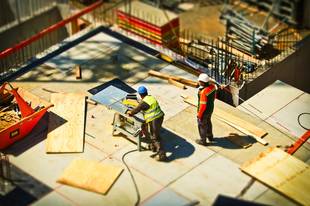
Urban Ecological Process
Amos Hawley (1901) advanced the different ecological processes which account for the changes in towns and cities.
Urban ecological processes refer to patterns of physical changes in the city and the way the people adapt to the changing urban environment. These processes include:
1. Concentration – It refers to the increase of the population in a given area which is determined by density of population. It occurs with the growth of towns and cities.
Example: Movement of people towards the city center.
2. Dispersion – It refers to the outward movement of population from city centers to the outlying sections.
Example: Movement of the upper and middle classes to the suburbs.
3. Gradient – It refers to the condition of receding degrees of dominance from a dominant center towards the adjoining areas. Dominance refers to the controlling social and economic position of the central business district in relation to the other areas.
Example: The central business district commands the highest land value in relation to other areas.
4. Centralization – It refers to the condition where various institutions and establishments are drawn together along lines of transportation and communication or to the cluster along the same street or the same area. Ex. In Manila the entertainment places are found along Mabini and M.H. del Pilar, Carriedo St. has its shoe stores; Raon St. has its electronic gadgets and music stores; and Remedios, Adriatico; its restaurants; and university belt encircles around Mendiola, C.M. Recto, Morayta and Espana; and the tourist belt along Roxas Blvd. and Intramuros.
5. Decentralization – It refers to the scattering of functions from the main business districts to the suburbs or outlying districts. It is the opposite of centralization. This comes about due to keen competition and high land value in the central district.
6. Segregation – If refers to the tendency of people belonging to the same ethnic grouping, religion, social class, or occupation to live together in an exclusive area.
Example: The formation of Chinatown, Muslim Community in Palanca St., Quiapo, Forbes Park for the elites; and squatter areas for the urban poor.
7. Invasion – It occurs when new types of people, institutions or activities enter an area previously occupied by a different type.
Ex. Residential areas along C.M. Recto are invaded by business and industry.
8. Succession or Conversion – It refers to the condition where invasion reaches the climax stage, that is, when the new inhabitants, institutions or new functions completely dominate or completely occupy the area.
Example: The swampy area of Teresa, Sta Mesa, Manila which used to be planted with kangkong in commercial quantity was converted to an area for an educational institution – the PUP; rice fields and other agricultural lands along the superhiway were converted to subdivisions and industrial sites.
9. Zoning – It is a procedure by which land parcels in the city are designated by law for specific purposes and the size of lots and the structures in them are regulated.
Example: school zone and hospital zone.
Urban Ecology and the Shape of Cities
Urban ecology is concerned with the configurations and relationships that occur among people, their activities, and the land they occupy. By studying urban ecology, we learn about the ongoing accommodations that human beings value as they pursue their social goals within a physical environment.
Attempts were made to map the spatial characteristics of urban areas. Light (195) presents six models of these spatial characteristics:
- Concentric Zone Model – It is a model of urban structure proposed by Burgess. According to this model, cities develop within a business district at the core, surrounded by an area of transition characterized by residential instability and high crime rates, beyond which are the various residential areas.
- Multiple Nuclei Model– It is a model or urban structure proposed by Harris and Ullman. According to this model, land uses, costs and interests cause a city to develop a series of nuclei, each with specialized activities.
- Sector Model – It is a model of urban structure proposed by Hoyt. According to this model, cities are composed of sectors, around a central business district, distributed along major transportation routes radiating outward from the center.
- Zoning– It is a procedure by which land parcels are designated by law for specific purposes and the sizes of the lots and the structures to them are regulated.
- Mega Structure– It refers to a type of futuristic urban architecture in which acres of living, working, and recreational spaces are supported high above the earth’s surface.
- New Town– It is a comprehensively planned settlement, usually near a larger metropolis, built to absorb urban growth in a systematic fashion.
Urban Planning and Renewal: Revitalizing the Cities
Urban planning is a means of directing the city’s physical and social growth and changes to provide a more healthy, pleasant and prosperous environment (Gist and Faun 1974; Panopio, 2004. P. 390). Implied here are not only structural and special arrangements but also provisions for employment, education, health, housing, safety and comfort. Included herein are plans, programs and projects designed to meet the overwhelming urban plight and problems and to improve the image of the city as truly a “city of man.”
Among the aspects of urban renewal are:
- Beautification and greening projects
- Renewal and disposal of garbage
- Housing projects
- Designs for easing traffic (MMDA)
- Infrastructure projects such as the construction of fly-overs and LRT II and III
- Slum improvement programs; slum clearance
- Provisions for livelihood and revenue generating projects
- Zoning policies
- Improving various services of the city
- Converting dumpsites into a housing and industrial center
- Imposing a regional tax in the suburbs
- Involvement of private sector groups, including developers, planners, bankers property owners and retailers in city programs
- Renovation and redevelopment projects
- Urban enterprise zone specific areas in which government regulations are reduced and firms located there are allowed substantial tax breaks
- Self-help projects among neighbourhood groups
- Preservation of buildings and houses with historical and architectural importance.


















